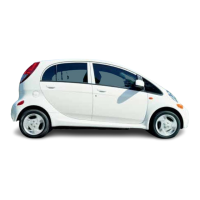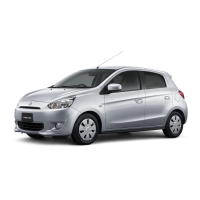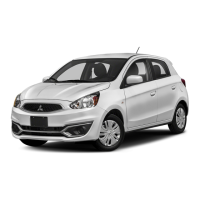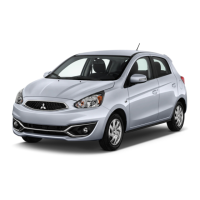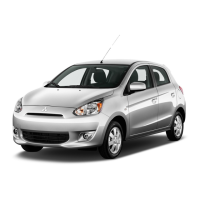Chapter 9 Brakes
6.7
Wheel cylinder-exploded view
1 Boots
2 Piston assemblies
3 Pistons
4 Piston cups
5 Wheel cylinder body
6 Wheel cylinder - removal, overhaul and installation
Refer to illustration 6.7
No&: /fan overhaulis indicated(usually because offluidleakage orsticky
opi?i%ion), explore all options before beginning the job. New wheel cylin-
ders are available, which make this job quite easy. If it’.. decided to rebuild
the wheelcylinder, makesure thata rebuildkitisavaitable beforeproceed-
ingI’ Never overhaul only one wheelcylinder-always rebuild both of them
at the same fme.
Removal
1 Raise therear of the vehicle and support it securely on jackstands.
Block the front wheels to keep the vehicle from rolling. ’
2 Remove the brake shoe assembly (see Section 5).
3 Remove all dirt and foreign material from around the wheel cylinder.
4 Disconnect the brake line using a flare-nut wrench. Don’t pull the
brake line away from the wheel cylinder.
5 Remove the wheel cylinder mounting bolts.
6 Detach the wheelcylinderfrom the brake backing plate and place it on
a clean workbench. Immediately plug the brake line to prevent fluid loss
and
contamination.
Overhaul
7 f Remove the bleeder screw, piston cups, pistons, boots and piston as-
semblies from the wheel cylinder body (see illustration).
8 Clean the wheel cylinder with brake fluid, denatured alcohol or brake
system cleaner. Warning: Do not, under any circumstances, use petro-
leum-based solvents to clean brake parts!
9 Use compressed air to remove excess fluid from the wheel cylinder
and to blow out the passages.
IO Check the cylinder bore for corrosion and score marks. Crocus cloth
can be used to remove light corrosion and stains, but the cylinder must be
replaced with a new one if the defects cannot be removed easily, or if the
bore is scored.
Ii Lubricate the new piston cups with brake fluid.,
12 Assemble the brake cylinder components. Make sure the lips on the
piston cups face in.
Installation
13 Place the wheel cylinder in position and install the bolts.
14 Connect the
brake
line and install the brake shoe assembly.
15 Bleed the brakes (see Section 9).
7 Master cylinder - removal, overhaul and installation
Refer to illustrations 7.7 la and 7.1 lb
Note: Before deciding to overhaul the master cylinder, check on the avail-
abikty and cost of a new or factory rebuilt unit and a/so the availability of a
rebuild kit.
Removal
1 The master cylinder is located in the engine compartment, mounted
to the power brake booster.
2 Remove as much fluid as you can from the reservoir with a syringe.
3 Place rags under the fluid fittings and prepare caps or plastic bags to
cover the ends of the lines once they are disconnected. Caution:
Brake
fluid will damage paint. Cover all body parts
andbe
careful not to spill ftufd
during this procedure. _
4 Loosen the tube nuts
at the
end:
of the brake
lines where they enter
the master cylinder. To prevent rounding off the flats on these nuts, the use-
of a flare-nut wrench, which wraps around the nut, is preferred.
5 Pull the brake lines slightly away from the master cylinder and plug
the ends to prevent contamination. On models with a remotely
mounted
fluid reservoir, disconnect the fluid hoses from the master cylinder and
plug the ends to prevent fluid loss.
6 Remove the mounting nuts and pull the master cylinder off the studs
and out of the engine compartment. Again, be careful not to spill the fluid
as this is done.
Overhaul
7 Before attempting the overhaul of the master cylinder, obtain the
proper rebuild kit, which will contain the necessary replacement parts and-
also any instructions which may be specific to your model.
8 Inspect the reservoir or inlet grommet(s) for indications of leakage
nearthe base of the reservoir. If the reservoiris attached to the master cyf-
inder, remove the mounting screw(s) and remove the reservoir.
9 Place the cylinder in a vise and use a punch or Phillips screwdriver to
fully depress the pistons until they bottom against the other end of the
master cylinder. Hoid the pistons in this position and remove the stop
bolt(s) on the side of the master cylinder. Remove the two check valves or
connector block and the copper gaskets.
10 Depress the pistons once again, then carefully remove the snap-ring
at the end of the master cylinder. Snap-ring pliers are needed on later
models.
11 The internal components can now be removed from the cylinder bore
(see illustrations). Make a note of the proper order of the components so
they can be returned to their original locations. Also note which direction
the lip of each seal faces so the new seals can be instaljed the same way:
Note: The two spnngs are of different tension, so pay particular atten&on
to their order.
12 Carefully inspect~the bore of the master cylinder. Any deep scoring or
other damage will mean a new master cylinder is required.
13 Replace all parts included in the rebuild kit, following any instructions
in the kit. Clean all reused parts with clean brake fluid or denatured alco-
hol. Do not use any petroleum-based cleaners. During assembly, lubricate
all parts liberally with clean brake fluid. Be sure to tighten all fittings and
connections securely.
14 Push the assembled components into the bore, compressing them
with the screwdriver or punch and install the stop bolt(s).
15 Compress the piston assemblies and install the new snap-ring, mak-
ing sure it is seated properly in the groove.

